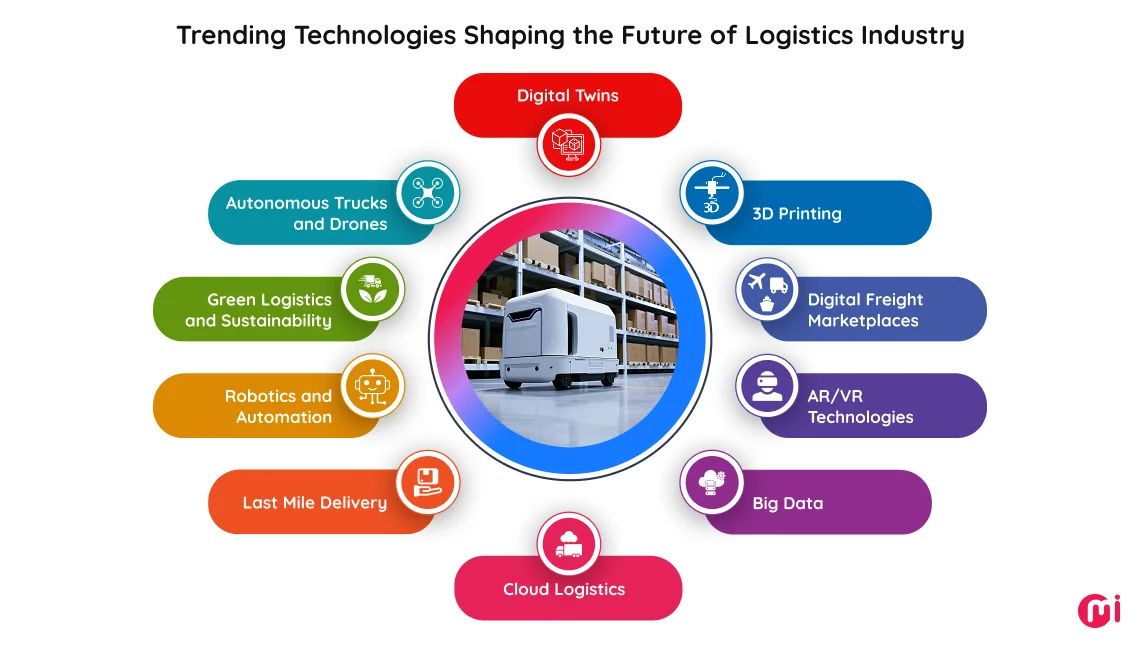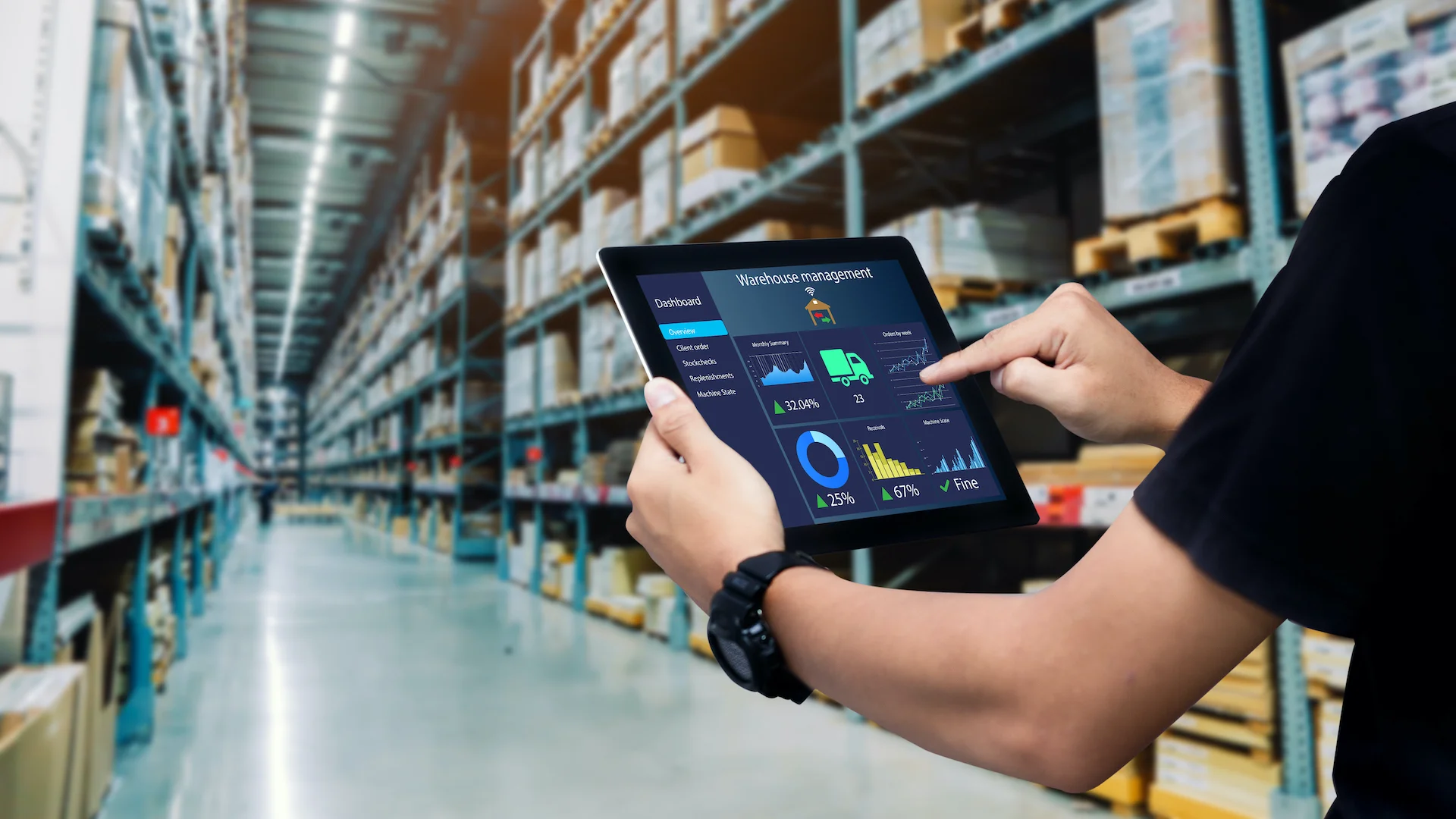How Technology Is Redefining the Logistics Business Landscape
- Business
- April 30, 2024
As international trade continues to grow, there is an increasing need for information technology in logistics businesses specifically, logistics software solutions to manage complex supply chains and ensure the timely delivery of goods across vast distances. Emerging technologies like IoT, robotics, automated warehouses, artificial intelligence, AR/VR, big data, cloud, digital twins, etc., are pushing the industry forward by reducing costs and enhancing customer satisfaction. This blog comprises a detailed overview of these advancements and their transformative impact on the logistics sector.
Gone are the days when logistics businesses tracked their shipments using traditional phone call-based reporting. With the rise of e-commerce, heightened consumer expectations for fast and reliable delivery, and expanding international trade deals, the logistics industry now requires a consistently connected ecosystem to effectively manage shipments.
Thanks to the adoption of the latest technology in logistics operations, businesses now have powerful tools to revolutionize the way goods are transported, stored, and managed. But this is just the beginning. The future promises even more advancements, further streamlining operations and enhancing efficiency.
In this blog, we’ll explore how technology is redefining logistics management and what to expect in the coming years. Join us as we dive into the dynamic evolution of technology in logistics and uncover the exciting innovations on the horizon.
Market Analysis of Use of Technology in Logistics Industry
The logistics industry plays a vital role in managing global trade and commerce, encompassing the movements of resources, services, goods, and information across various sectors. Over the years, the industry has evolved, adapted technology, and left the traditional business methods behind. The changes have positively impacted its growth and market share.
Here is a market analysis of this evolution and significant change.
- The logistics industry attained a market value of nearly USD 10.59 trillion in 2023. It is expected to hit the mark of USD 18.35 trillion by 2032 at a CAGR of 6.3% from 2024 to 2032.
- Regions, including Latin America, North America, Africa, the Middle East, Europe, and the Asia Pacific, will acquire the maximum market share. Among these countries, Asia Pacific will have the largest share of the market.
- Surging demand in the retail sector, e-commerce, rapid urbanization, disposable incomes, and the latest technical advancements will contribute to market growth.
- Environmental issues have led to the demand for sustainable and eco-friendly practices in the logistics industry. Companies are planning to switch to eco-friendly ways of transporting goods and services.
- Logistics companies will use alternative fuels, green energy, and electric vehicles and optimize route planning to reduce carbon emissions.
- The industry will experience a surge in demand for efficient last-mile delivery, warehousing, solutions, and cross-border logistics to fulfill customer orders.
- Companies will explore innovative solutions like urban distribution centers and micro-fulfillment centers to address growing issues such as urbanization and lack of infrastructure.
- More logistics businesses are planning to adopt technologies like IoT, AI, and blockchain for real-time tracking, predictive analytics, and transparency.
- Around 70% of businesses are found having real-time supply chain visibility as their core strategic roles, says Geodis.
- As per S&P Global, 40% of industry people consider cloud computing as the most impactful technology to adopt for digital transformation in logistics.
- Around 50% of companies in the industry have a freight tracking system in place.
In short, the logistics industry is poised for continued growth, driven by ongoing technological advancements, increasing demand for efficient and transparent supply chains, and the expansion of global trade.
Role of Technology in the Logistics Industry’s Growth
Technology has propelled the growth of logistics companies and helped organizations automate, manage, and streamline complex and manual operations. However, this automation is just the beginning of a remarkable contribution.
Technology has completely transformed the way logistics businesses carry forward their operations. Here is a detailed insight into the role of technology in logistics management:
1. Warehouse Automation
Warehouse management system software controls and manages various warehouse operations, including inventory tracking, order processing, shipment coordination, etc. It optimizes the use of resources and gives insights into real-time data for better decision-making.
Moreover, conveyor systems incorporated with automation technology sort and move goods within the warehouse. They streamline order processing and fulfillment, reduce manual handling, and enhance accuracy.

2. Streamlined Data Flow
Streamlined data flow also supports automation, allowing technologies like AI, IoT, and route optimization tools to work effectively with up-to-date information. Also, modern data analytics tools collect and process huge volumes of data from various sources and identify trends, patterns, consumer preferences, and industry insights.
This data-driven approach supports logistics companies in predicting demand, optimizing routes, and fulfilling orders on time. Along with it, technology has facilitated the incorporation of advanced logistics software systems for transportation management, warehouse management, enterprise resource management, etc.
3. Improved Visibility
IoT devices and sensors offer real-time tracking of shipments, monitoring the condition of goods, and providing detailed insights into supply chain performance. This enhances visibility, allows for proactive problem-solving, and improves overall transparency.
4. Better Transparency
Blockchain enables secure, transparent, and tamper-proof record-keeping. It helps in verifying transactions, ensuring authenticity, and tracing the provenance of goods, thereby enhancing trust and reducing fraud.
5. Uptight Security
Technology in logistics and supply chain management has ensured uptight security with its advanced safety measures against theft, fraud, cyberattacks, and unauthorized access. Access control systems leverage technologies like RFID cards, biometric authentication, and keypad entry to limit access to authorized personnel only, preventing unauthorized entry to sensitive areas.
6. Seamless Order Management
Tech tools, software, and robotics have automated manual and repetitive tasks like data entry, inventory management, order processing, etc. The initiative has led to increased operational efficiency, reduced errors, and faster processing time, allowing logistics companies to manage large volumes of orders and shipments.
7. Optimizing Transportation and Route Planning
Having data analytics and predictive algorithms in logistics software solutions optimizes route planning, reduces fuel consumption, and improves delivery times. By analyzing historical data and real-time traffic conditions, logistics companies can make more informed decisions.
The integration of GPS and telematics with logistics software systems allows real-time monitoring of fleet performance, including vehicle location, fuel usage, and driver behavior. This improves fleet efficiency, reduces maintenance costs, and enhances safety.
8. Better Connectivity
Technical advancements and logistics software solutions have enabled seamless communication, data transfer and exchange, team collaboration, and networking for logistics companies. With this, logistics professionals can access critical information, share and transfer data privately, track shipments, and manage operations efficiently. The connectivity that technology has offered is at par as compared to the traditional era, where communication was limited to calls and messages.
9. Easy Access
With its advanced measurements and inventions, technology ensures easy access for logistics companies and their consumers. It offers convenient tools for both parties, streamlining operations and increasing customer satisfaction. Technologies, including mobile apps, cloud-based solutions, remote monitoring systems, automated reporting, data analytics dashboards, etc., keep employees updated with the latest ongoings.
10. Paperless Document Handling
Technologies like Electronic Data Interchange (EDI), Document Management Systems (DMS), digital signatures, Electronic Bill of Lading, electronic invoicing, mobile apps, scanning, and OCR have streamlined the documentation process. They have eliminated the need for keeping records on paper and transferred the work to technology, ensuring paperless document handling, record keeping, increased efficiency, reduced errors, and an environment-friendly approach.
11. The Surge in Consumer Demand
Technology has shifted the demand and enabled consumers to place orders anytime, anywhere. It has cut down latency and delays in order placing, supply chain management, and order fulfillment. These advancements have spiked consumer demand, bringing more profits and customers to the industry.
12. E-Commerce Growth
Technologies such as drone delivery, autonomous delivery vehicles, and advanced logistics platforms address the growing demand for fast and efficient last-mile delivery. These innovations help meet customer expectations for rapid fulfillment. Logistics software solutions can also be equipped with machine learning algorithms to predict demand trends and optimize pricing strategies, allowing businesses to better manage inventory and respond to market fluctuations.
13. Long-Term Relationships with Clients
Technology helped logistics companies foster long-term relationships with clients by providing improved communication, real-time tracking, automated notifications, customer portals, data analytics, personalization, supply chain visibility, and exceptional management.
14. Better Customer Experience
Logistics businesses can also have a real-time report-sending feature in their software solution to enable customers to track their shipments in real time, access delivery updates, and communicate with service providers through user-friendly portals and apps. Moreover, AI-powered chatbots like Replika offer 24/7 customer support, answer queries, and handle routine tasks, improving customer service and operational efficiency.
15. Enablement to Global Trade
Technology facilitates smoother cross-border logistics through automated customs clearance, compliance management, and international trade documentation. This helps in navigating complex regulations and reducing delays in global trade.
Not just that, the enablement of mobile apps for logistics operations can also provide many conveniences to businesses, which we have mentioned in the linked blog.
In short, technology is a key driver of growth in the logistics industry, offering solutions that enhance efficiency, transparency, and customer satisfaction. By leveraging innovations such as automation, IoT, blockchain, and advanced analytics, logistics companies are transforming their operations, meeting the demands of a rapidly evolving market, and paving the way for future growth.
Emerging Technology Trends of Logistics Industry
The logistics industry is on the brink of a technological revolution, with emerging trends set to transform how goods are managed, transported, and delivered. Here are some key upcoming technology trends in logistics that are worth following:

1. Artificial Intelligence
AI algorithms will examine the history, collected data, and external factors to determine market and consumer demand precisely. These algorithms will handhold logistics companies to allocate resources, optimize routes, and plan inventory levels and delivery schedules.
Artificial intelligence will monitor data collected from equipment and sensors to predict maintenance requirements. It will identify issues earlier than before they cause breakdowns, helping the logistics company reduce downtime, maintenance costs, and disruptions.
AI-powered tools will support automated warehousing, risk mitigation, cognitive automation, dynamic pricing, supplier collaborations, etc., ensuring continuous improvement and flawless operation management.
2. Internet of Things (IoT)
Integrated IoT sensors attached to vehicles, shipments, and assets provide real-time tracking and visibility. Apart from monitoring locations, companies can analyze temperature, humidity, goods condition, fuel consumption, driving behavior, etc.
The information will help them reduce delays and goods restocking, avoid excess inventory, and improve fuel efficiency and transparency throughout the process.
3. AR/VR Technologies
AR will display real-time information using smart glasses, assisting the team in various tasks, like inventory management, order picking, and navigating through large warehouses. AR overlays instructions or annotations onto the field of view to help remote experts guide and instruct on-site experts.
On the other hand, VR will contribute to enhancing training experiences for new employees, helping them learn safety protocols, operation management, and other on-site tasks in a controlled virtual environment. It will enable managers to assist virtually and review layouts, identifying potential issues digitally.
4. Big Data
Big data integrations will empower the logistics industry to process and analyze large amounts of data for better and faster decision-making. It will transfer the logistics ecosystem with data-driven solutions and provide valuable insights into customer behavior, demand patterns, resource allocation, and operational bottlenecks. Big data will predict the issues at an early stage and help the organization find efficacious solutions to tackle them.
5. Cloud Logistics
Cloud computing solutions have gained a significant position in logistics technology trends. Cloud-based systems support data centralization and unify data from multiple sources, varying from suppliers, manufacturers, and carriers to consumers.
The unified data repository will enhance visibility, predictive analysis, and decision-making power for logistics companies. It will also facilitate real-time collaboration among supply chain partners and help accommodate changes in business according to market demand, seasonal fluctuations, growth parameters, and risk factors.
6. Autonomous Trucks and Drones
With round-the-clock operation, these trucks will drastically reduce delivery times and help logistics providers meet growing customer demands for faster shipping. Their ability to function without breaks or shift limitations addresses the ongoing challenge of driver shortages, which has long hindered supply chain continuity. Additionally, automation will lead to fewer delays and lower operational risks, as consistent driving patterns and AI-driven decisions reduce the chance of accidents and delivery disruptions.
Drones will deliver small packages quickly in urban areas, remote locations, and hard-to-access areas where humans can’t reach easily. The use of drones will significantly cut off last-mile delivery costs, help avoid traffic and vehicle requirements, and tackle emergencies.
7. Robotics and Automation
In warehouses, automation streamlines operations through technologies like Automated Guided Vehicles (AGV), which follow pre-set paths to move pallets and products. Moreover, Autonomous Mobile Robots (AMR) are more advanced and can navigate dynamic environments using sensors and AI.
These systems significantly improve efficiency, allowing 24/7 operations while reducing human error and labor costs. Robotic arms are also increasingly used for picking, packing, and palletizing items, while automated conveyor belts facilitate fast movement of goods across warehouse zones.
8. Digital Twins
In logistics, digital twins help create virtual models of warehouses, transportation systems, and supply chains to simulate, monitor, and optimize performance. Companies are using digital twins to enhance warehouse efficiency by testing different layouts and workflows digitally before applying them in the real world. In supply chain management, digital twins provide end-to-end visibility, allowing companies to predict delays, optimize delivery routes, and respond quickly to disruptions.
9. 3D Printing
Traditionally, logistics depended heavily on large inventories and long-distance shipping. However, with 3D printing, companies can produce parts and products on demand, closer to the point of use, reducing the need for warehousing and transportation. This technology enables decentralized manufacturing, where spare parts or customized products can be printed locally, minimizing delivery times and shipping costs.
It also reduces supply chain risks, as businesses no longer rely solely on distant suppliers or large bulk orders. Additionally, 3D printing allows for more customization without increasing production costs, which is especially valuable in industries like healthcare, aerospace, and automotive.
10. Digital Freight Marketplaces
Digital freight marketplaces connect shippers with carriers, streamlining the booking process and managing freight transportation. Traditionally, freight booking involved manual processes, phone calls, and paperwork, leading to delays and inefficiencies. Digital freight marketplaces eliminate these issues by offering real-time pricing, availability, and tracking, all in one place.
For carriers, these platforms provide access to a wider network of potential customers, helping reduce empty miles and increase profits. With features like dynamic pricing, load matching, and automated documentation, digital freight marketplaces reduce operational costs and improve logistics efficiency.
11. Last Mile Delivery
With the rise of e-commerce and customer expectations for same-day or next-day delivery, logistics companies are under pressure to make the last-mile delivery faster, more efficient and reliable. Innovations such as route optimization algorithms, real-time tracking, electric delivery vehicles, drones, and autonomous delivery robots are being adopted to address these challenges.
Moreover, companies are experimenting with local fulfilment centers and micro-warehouses closer to urban areas to speed up deliveries and reduce transportation distances.
12. Green Logistics and Sustainability
The adoption of electric trucks and vans contributes to reducing carbon emissions and supports sustainable logistics practices. Moreover, having access to an app to find nearby EV charging stations can help logistics businesses make their green logistics more convenient and affordable, facilitating better adoption.
Staying ahead of these technology trends will be crucial for logistics companies looking to maintain a competitive edge. By embracing innovations such as autonomous vehicles, AI, IoT, and blockchain, the logistics industry can enhance efficiency, improve customer satisfaction, and drive future growth.
Moreover, there are also many industry-leading logistics app features that you should consider implementing in your solution along with these logistics technology trends to leverage technology in logistics businesses effectively.
Why Should You Invest in Logistics App Development?
A smart investment in logistics app development brings a myriad of benefits to the company. It pushes the growth forward, adds in revenues, increases sales, and provides customized solutions to users, retaining them for a longer period. These benefits are the beginning of the list. There are a lot more to consider.
Let’s explore some of the promising advantages of information technology in logistics:
Predictive Demand Forecasting
Demand prediction is one of the prime reasons to invest in logistics application development. These apps analyze data analytics, sales patterns, consumer behavior, economic indicators, historical data, geographic location, consumer preference, and other market trends.
Based on the result of this analysis, they predict market demand and upcoming fluctuations. This feature helps companies plan their business strategies and launch or expand their services efficiently.
Route Optimization and Dynamic Scheduling
Logistics apps leverage advanced algorithms, real-time data, and geospatial technology for efficient route planning and scheduling. They collect information through maps, traffic data, road networks, and points of interest to create a comprehensive view of the traffic environment.
They optimize the route and schedule the delivery after identifying traffic congestion, road closures, accidents, and other disruptions.
Risk Management and Fraud Detection
Logistics apps support real-time tracking and visibility into the movement of goods from the pickup point to the drop-off location. The app helps the logistics company determine any deviations from the planned route or delivery schedule, indicating the risk of theft, fraud, delays, and unauthorized stops due to unexpected situations.
Moreover, these apps use advanced algorithms and technical features for route optimization, record maintenance, document verification, data analysis, risk analysis, and management. These proactive approaches enable companies to mitigate risks, detect fraud and take disciplinary actions on time.
Smart Contracts and Secure Transactions
Logistics apps take the support of Blockchain technologies to create and execute smart contracts, which is a type of self-executed agreement with predefined rules. These contracts can automate payment release after the confirmed delivery of the goods. They ensure all parties agree to the terms and conditions without the need for intermediaries. These contracts promote transparency, traceability, data integrity, and security.
Along with it, logistics apps also ensure safe transactions through integrated secured payment gateways. The system follows security protocols and safeguards payment information with safety practices, including data encryption, tokenization, multi-factor authentication, role-based access controls, and digital signatures.
Improved Efficiency and Speed
Custom logistics apps streamline operations, automate manual tasks and regulate the overall workflow. This regulation leads to increased productivity and faster delivery, resulting in cost savings and better customer experience.
Cost Savings and Resource Optimization
Logistics applications optimize routes and resources after considering crucial factors like distance, traffic and weather conditions, delivery schedules, fuel efficiency, inventory, stock levels, market demand, carrying costs, and lost sales.
They contribute to cost savings through demand forecasting, inventory management, warehouse optimization, supplier collaboration, reverse logistics management, data analytics, vehicle maintenance, etc.
Eco-friendly Practices and Sustainability
Logistics applications select short and efficient routes that help reduce fuel consumption, greenhouse gas emissions, and overall environmental impact. They also facilitate load consolidation and combine multiple shipments into a single load. The effort reduces the number of trips, leading to less emissions, fuel consumption, and reduced congestion on roads.
These apps promote sustainability by suggesting alternative transportation modes, carbon footprint tracking, real-time monitoring, return of products for recycling and proper disposal, optimizing warehouse space, and reducing energy consumption and waste generation.
Customer Experience and Satisfaction
Logistics apps ensure effective supply chain management, self-service options, dedicated support, accurate delivery time estimation, order tracking, secure payments, easy return and exchange, and data-driven improvements. These efforts enhance customer experience and help the logistics company maintain long-term relationships with other businesses and customers.
Read also: How to Develop A Logistics App: A Step- by-Step Guide
Comprising it all, investing in logistics app development is a strategic move that will enhance the operational efficiency of your business and customer experience and help you stay ahead of your competitors. It will enable you to leverage technology, optimize processes, automate reactive tasks, drive growth, and adapt to changing market dynamics.
However, you need a reliable logistics app development company to design an advanced app for your business. MindInventory is the perfect choice you have been looking for all this while.
Why Choose MindInventory for Logistics App Development?
MindInventory has extensive expertise, experience, and resources needed to customize the app with the latest technical advancements. Our dedicated team deploys a feature-rich, user-friendly, high-end, and functional app to meet your end requirements and help you handle logistics operations efficaciously.
We understand the intricacies and evolving demands of the industry, including regulations, challenges, and trends, and tailor your app accordingly. We also offer round-the-clock support and maintenance services to handhold you in times of need and keep the app updated with the latest technologies.

FAQs on Logistics Software Solutions
Logistics apps manage data related to shipments, custom requirements, documentation, and other regulatory aspects. They automate the creation, processing, and storage of important documents, including bills, certificates, user authentication, custom declarations, origin certificates, and insurance record. They keep the system and information up to date according to the latest regulations.
The cost of developing a logistics app can range from $8,000 to $100,000 and even more depending on various factors. These include the complexity of tech stack, complexity, platforms, development tools and technologies, app features, programming language, length, and deadline.
Digital transformation of the logistics industry involves the integration of digital technologies, processes, and strategies to optimize operations related to logistics and supply. These technologies enhance efficiency, customer experience, security, and transparency within the sector.













